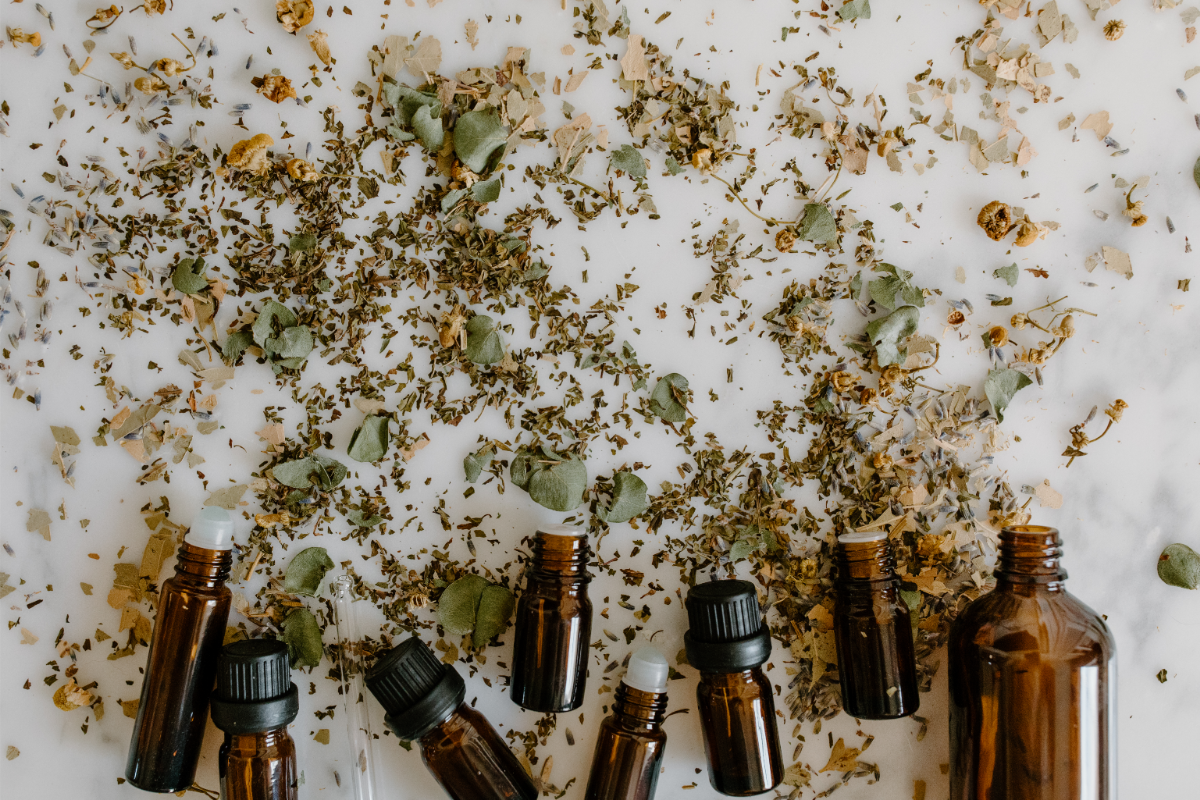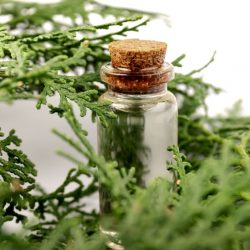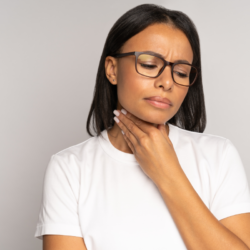Thanks to their highly potent active molecules, essential oils make an effective contribution to curbing ENT disorders, which are very common and the cause of many of our ailments. They are one of the main reasons for consulting a doctor. We often tend to play them down and wait for them to go away… But their symptoms can be very annoying and painful.
Conventional treatments are increasingly coming up against the growing resistance of viruses and bacteria.
Here are a few recipes or formulas you can prepare yourself to treat ENT problems using essential oils:
What to do about rhinitis?
What is rhinitis?
Rhinitis is a respiratory condition characterised by inflammation of the nasal mucosa. It can be caused by a viral or bacterial infection, or by an allergic reaction or irritation of the airways. The symptoms of rhinitis are numerous and can vary depending on the cause of the inflammation.
The most common symptoms of rhinitis are :
- Nasal discharge: Excessive production of clear or greenish mucus, often thick.
- Nasal itching: Irritation of the nasal mucosa, causing itching and the need to blow the nose frequently.
- Sneezing: Frequent, may be accompanied by watery eyes and redness of the eyes.
- Nasal congestion: Tightness of the nasal passages, difficulty breathing through the nose, wheezing and a feeling of a blocked nose.
- Headache and facial pain: Caused by the pressure of mucus on the nasal walls.
- Fatigue: Breathing difficulties and lack of sleep.
Allergic rhinitis often manifests itself as frequent sneezing and watery eyes, while viral rhinitis can cause fever and chills. It is vital to consult a doctor for an accurate diagnosis.
Standard treatment includes nasal decongestants and antihistamines to ease symptoms. Adequate rest and hydration are recommended to help eliminate mucus. In the case of allergic rhinitis, it is essential to limit exposure to allergens and to take specific medication to manage allergic reactions.
Which essential oils should I use?
- Niaouli 2 drops
- Ravintsara 3 drops
- Sateoid Thyme 2 drops
- Peppermint 2 drops
- Juniper 1 drop
6 to 8 drops of the essential oil blend on the chest and back 3 to 4 times a day for 3 days. And/or 3 drops of essential oils from the blend on a handkerchief to be inhaled several times a day.
Niaouli essential oil has expectorant and mucolytic properties, thanks to its component 1,8 cineole. It stimulates the exocrine glands of the respiratory mucosa, increasing the activity of the cilia in the nasal mucosa and inducing a bronchodilator effect. Niaouli is effective against nasal congestion caused by infectious colds. It is a good anti-infective and antiviral for the ENT and respiratory tracts. This essential oil also has an anti-inflammatory and analgesic action, similar to that of corticoids. It acts as an immunomodulator and febrifuge.
Ravintsara leaf essential oil is also expectorant and mucolytic, stimulating the mucin glands and the ciliomotor activity of the bronchial mucosa. It has an anti-inflammatory action thanks to 1,8 cineole. It is antimicrobial and has antiviral, neurotonic, stimulating and immunomodulating effects.
Savory Leaf Thyme essential oil contains several components, including borneol, alpha terpineol and thymol, which give it antibacterial, tonic and immunomodulating properties. It is effective against various types of infection and stimulates the immune system.
Peppermint leaf essential oil is analgesic and anti-inflammatory, and is particularly effective against migraines. It is also antibacterial and can help reduce antibiotic resistance. It stimulates the central nervous system and has nasal decongestant and secretolytic properties.
Finally, Juniper berry essential oil has antimicrobial properties against various bacteria, as well as antiviral and antifungal effects. It is also expectorant, thanks to α-pinene, and has cerebral tonic and anti-asthenic properties.
Which essential oils for rhinopharyngitis?
What is rhinopharyngitis?
Rhinopharyngitis is an infection of the upper respiratory tract that mainly affects the nose, throat and sinuses. It is caused by viruses or bacteria, and is often accompanied by symptoms such as fever, runny nose, cough and sore throat.
The most common symptoms of rhinopharyngitis include high fever, nasal congestion, clear or yellowish nasal discharge, dry or productive cough, sore throat and headache. Some people may also experience ear or sinus pain, as well as general tiredness and weakness.
In the event of rhinopharyngitis, it is important to rest and drink enough water to avoid dehydration. Medication such as antihistamines and nasal decongestants can relieve symptoms, while analgesics such as ibuprofen or paracetamol can help relieve fever and pain.
It’s also important to wash your hands regularly and cover your mouth and nose when coughing or sneezing to avoid spreading the infection to others. If symptoms persist or worsen, it is advisable to consult a doctor to assess the need for antibiotic therapy.
Which essential oils should I choose?
- Eucalyptus radiata 1 drop of essential oil
- Common myrtle 1 drop of essential oil
- Ravintsara 1 drop of essential oil
Inhalation. Pour the drops of essential oil into a glass of very hot water and breathe for 1 to 3 minutes. Repeat 1 to 2 times a day.
Eucalyptus Radiata essential oil, extracted from the leaves of Eucalyptus radiata A.Cunn. ex DC. is renowned for its effectiveness in treating respiratory problems. It is particularly useful during winter and epidemic periods for its soothing and immuno-stimulating properties. Its composition includes approximately 8% monoterpenes (Alpha-pinene, Beta-pinene, Limonene, Myrcene, Sabinene), 20% monoterpenols (Alpha-terpineol, Terpinene-4-ol, Borneol, Geraniol), 3% terpene esters (Alpha-terpenyl acetate) and 62 to 74% terpene oxides (1,8-cineole).
1,8-cineole, or eucalyptol, plays a key role in stimulating the exocrine glands of the respiratory mucosa, helping to thin secretions and expel mucus. It also has bronchodilator properties, relaxing the smooth muscles of the airways. The combination of alpha-terpineol and eucalyptol offers powerful antiviral action, particularly against the infectious bronchitis virus (IBV), and stimulates immunity. The essential oil is also effective against certain bacterial and fungal strains, and reduces the production of pro-inflammatory molecules.
In addition, this oil has antioxidant, parasiticidal, pediculicidal and cutaneous properties. It is used for its airborne antiseptic, expectorant, mucolytic, decongestant and immune-stimulating qualities. It is particularly indicated for respiratory and ENT infections, asthenia and immune deficiencies.
The essential oil extracted from the twigs of red myrtle has antibiotic properties, mainly due to the presence of myrtucommulones. This oil is antibacterial, antiviral and antifungal. It is also recognised for its expectorant, mucolytic, decongestant and antitussive effects. In vitro studies have demonstrated its anti-inflammatory action, notably by reducing inflammation mediators.
What to take for sinusitis
What is sinusitis?
Sinusitis is an inflammation of the nasal cavities, characterised by an accumulation of mucus and painful pressure in the sinuses.
Nasal congestion is one of the most common symptoms of sinusitis. It manifests itself as a feeling of a blocked nose or difficulty breathing. Nasal discharge, also known as rhinorrhea, is also common. It can be clear or green and can cause itching and throat irritation.
Headaches are also common when the sinuses are inflamed. They may manifest as a dull or pulsating pain in the temples, forehead or cheeks. Facial pain is also common and can be felt in the cheeks, nose and teeth.
Loss of smell and taste is another common symptom of sinusitis. This is due to inflammation of the nasal mucosa, which can impair the ability to smell and taste. Fatigue and fever are also common symptoms of sinusitis, as the inflammation can cause pain and discomfort, which can lead to loss of sleep and reduced appetite.
It is important to consult a doctor if you are experiencing symptoms of sinusitis, as appropriate treatment can help relieve pain and reduce the duration of the illness. Medications such as decongestants, antihistamines and antibiotics can be used to relieve the symptoms of sinusitis. In cases of chronic sinusitis, surgical procedures may also be recommended.
Which essential oils should I use?
- Tea-tree 2 drops of essential oil
- Spike lavender 2 drops of essential oil
- Ravensare 2 drops of essential oil
- Peppermint 1 drop of essential oil
2 drops of the essential oil mixture applied locally to the forehead 4 times a day for 3 days and/or 2 drops of the mixture on ¼ of a sugar cube to be sucked twice a day
Tea tree essential oil, a must in aromatherapy, is composed mainly of monoterpenes (40-45%), monoterpenols (45-50%), and oxides (3-5%), with terpinene-4-ol as the major component. The latter is effective against infections, particularly staphylococcal and candidiasis, and acts by disrupting the bacteria’s cell membrane. The oil is renowned for its antiviral, antifungal and anti-infectious properties. It is also ‘eubiotic’, targeting only harmful bacteria while preserving the natural flora, and can reinforce the effectiveness of antibiotics. Therapeutically, tea tree oil is a broad-spectrum antibacterial, antiviral and immune stimulant. It is also a tonic for the body, heart and mind.
Lavender aspic essential oil has anti-inflammatory and analgesic properties, thanks in particular to camphor and 1,8-cineole. It is useful against respiratory infections and has antibacterial and antifungal properties.
Ravensara aromatica oil, derived from the leaves of this plant, contains monoterpenes and sesquiterpenes, giving it anti-inflammatory and analgesic effects. It is also antispasmodic, relaxing, antiseptic and immunostimulant, and is used to treat a variety of conditions, including musculoskeletal and ENT.
Finally, Peppermint essential oil is recognised for its analgesic and anti-inflammatory effects, particularly in cases of migraine. It also has antimicrobial and tonic properties, as well as nasal decongestant action. Juniper oil, for its part, offers antimicrobial and expectorant properties, effective against various infections and respiratory disorders.
How is tonsillitis treated?
What is angina?
Angina is an infectious disease that mainly affects the upper respiratory tract, such as the throat and tonsils. It is caused by a bacterial or viral infection, and can manifest itself in different ways depending on the severity of the illness.
The most common symptoms of strep throat are pain or discomfort in the throat, and swelling and redness of the tonsils. People with strep throat may also experience fever, chills, headache and fatigue. The lymph nodes under the chin and in the neck may also be swollen and painful.
Pain in the throat is generally the most striking symptom of angina. It may feel like a burning, sharp pain or discomfort when swallowing. The pain may also extend to the ears and neck. Coughing, nasal congestion and sneezing are also common in people with angina.
People with angina may also suffer from voice disorders, such as hoarseness or loss of voice. The tonsils may be swollen and white or pasty, which is a sign of pus. People with angina may also have difficulty opening their mouths or breathing, due to swollen tissues.
It’s important to see a doctor if you think you have strep throat, as you may need antibiotic treatment to fight the infection. Antibiotics are effective in killing the bacteria that cause strep throat, but they are not effective against viruses. If you experience fever, chills, vomiting or abdominal pain, you should also consult a doctor, as these symptoms may indicate a complication of angina.
Which essential oils should I choose?
- Laurel 2 drops
- Tea-tree 2 drops
- Rosemary verbenone 2 drops
2 drops of the blend of essential oils to be ingested in a spoonful of vegetable oil 3 times a day
- Rosemary cineole EO 2 drops
- Eucalyptus radiata EO 2 drops
Mix these essential oils with 3 drops of hazelnut vegetable oil and massage into the throat.
Laurel leaf essential oil is particularly effective for its antimicrobial properties, acting as a powerful bactericide, virucide and fungicide. This oil also has a notable antiviral action. At the same time, it has analgesic and anti-inflammatory properties, thanks in particular to 1,8-cineole, which reduces the mediators of pulmonary inflammation. It is also recognised for its expectorant and mucolytic qualities, stimulating the exocrine glands of the respiratory mucosa.
Tea Tree essential oil is made up of monoterpenes, monoterpenols and oxides, with terpinen-4-ol as its main active ingredient. This component has a powerful anti-infectious action, as well as being antiviral. Tea Tree oil is also appreciated for its eubiotic properties, targeting only harmful bacteria. Its antioxidant properties are due to alpha-terpinene and gamma-terpinene.
Rosemary Verbenone essential oil is rich in alpha-pinene, 1,8-cineole, borneol, camphor and verbenone, giving it expectorant, mucolytic and antiviral properties. It is also antibacterial.
Rosemary ct Cineole essential oil has antimicrobial properties, particularly against Staphylococcus aureus. It is also expectorant, mucolytic, anti-inflammatory and a specific analgesic for pulmonary and respiratory ailments.
Eucalyptus Radiata essential oil is made up of monoterpenes, monoterpenols, terpene esters and terpene oxides, with a strong presence of 1,8-cineole. This oil is particularly effective in treating respiratory ailments, thanks to its expectorant, mucolytic, antiseptic and anti-inflammatory properties. It is also recognised for its stimulating action on the immune system and its ability to purify the air.
How can an ear infection be treated naturally?
What is an otitis?
An ear infection can cause intense pain and other unpleasant symptoms. It usually occurs when bacteria or viruses enter the middle ear, causing inflammation and a build-up of fluid. There are two main types of otitis media: acute and chronic.
The most common symptoms of acute otitis media include ear pain, fever, ear discharge, hearing loss, dizziness and irritability. Ear pain is generally one of the most common symptoms and can be very intense. It can be described as a sensation of pressure or burning inside the ear. Fever is also common, as inflammation of the middle ear can cause a rise in body temperature.
Ear discharge is also a common symptom of acute otitis media. It may be clear or yellowish and may be accompanied by an unpleasant odour. Hearing loss is also common, as the accumulation of fluid in the middle ear can obstruct the passage of sound waves. Dizziness, vertigo and irritability can also be caused by inflammation of the middle ear.
Chronic otitis media is a type of ear infection that occurs when inflammation of the middle ear persists for a prolonged period. Symptoms can include recurrent ear pain, ear discharge, hearing loss and dizziness. It is important to consult a doctor if you suspect you are suffering from otitis, as it is important to start treatment as soon as possible to avoid potential complications. Common treatments include antibiotics, analgesics and anti-inflammatories.
Which essential oils should I use?
- Tujanol thyme 2 drops of essential oil
- Rosemary verbenone 2 drops of essential oil
- Ravensare 2 drops of essential oil
2 drops of the mixture on a carrier 3 times a day.
Thyme ct thujanol flower essential oil is distinguished by its many pharmacological properties. It stimulates the immune system and has a notable antiseptic action, particularly against germs such as Helicobacter pylori and various microscopic fungi. It has a marked antimicrobial effect, with antiviral, anti-infectious, bactericidal, virucidal and fungicidal actions, particularly effective against gynaecological infections.
This essential oil also increases immunoglobulin A and stimulates hepatocyte regeneration. It also has neurotonic effects, balancing the central and autonomic nervous systems and activating blood circulation.
Rosemary Verbenone essential oil, rich in alpha-pinene, 1,8-cineole, borneol and camphor, has expectorant, anti-catarrhal and mucolytic properties. It acts on mucus-secreting cells and bronchial secretions, and is particularly effective against herpes viruses.
Ravensare essential oil, extracted from Ravensara aromatica, is made up of monoterpenes, sesquiterpenes and terpene phenols, with the main active ingredients being limonene, sabinene and alpha-terpinene. This composition gives it antiseptic and immunostimulant properties, making it suitable for treating urinary tract and skin infections. It is also used to prevent viral diseases and ENT infections, and to treat conditions such as measles, German measles, chickenpox and shingles.
What precautions should I take?
The use of essential oils can be dangerous and should be treated with particular care. The use of essential oils is not a substitute for a consultation with your doctor or for ongoing treatment.
The usual precautions should be taken: follow the dosage carefully, carry out a skin test beforehand (put 1 drop of the essential oil on the crease of the elbow and check that there is no reaction in the 24 hours following application), avoid exposure to the sun in the hours following application and do not apply to damp skin.
Please note that the instructions given in this article are for adults only; do not give them to children! There are other specific formulas for children.





